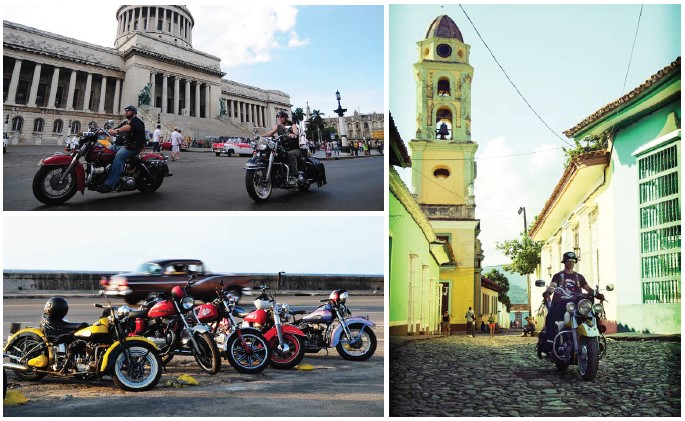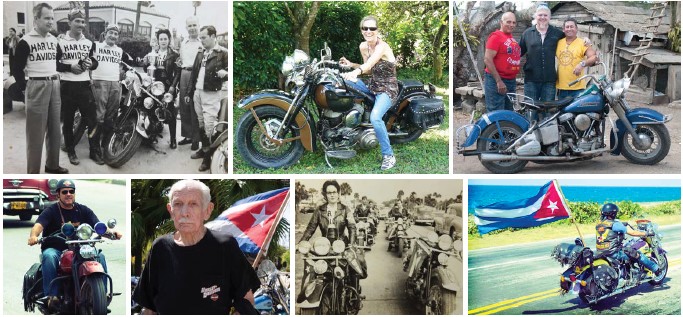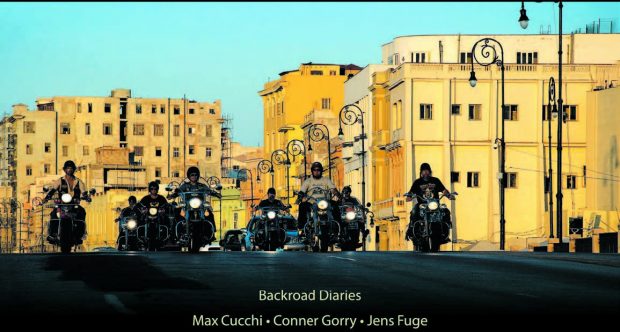Cuban Harleys, Mi Amor
Cuban Harleys, Mi Amor
Backroad Diaries
Cuba from the perspective of a small, unique subculture; 50 portraits of people who have resistedand have kept their Harley-Davidson motorcycles neat and tidy.
In 1967, the Government ordered all Police-Harleys be buried in a hole in a prison in Santiago de Cuba for ideological reasons. Then, in the 70s and 80s, spare parts were nowhere to be found, so Cuban Harlistas cannibalized parts from Russian cars and adapted them according to their needs – pistons from Ladas and valves from Kamas, while exhaust pipes were made from old transformers.
A Harley was only worth a tip, nobody wanted these big and expensive bikes. Especially not in the “Periodio Especial” following the fall of the Socialist bloc, when an economic crisis almost drove the country to its knees, famine ruled and gas was unaffordable.
Against all odds, “Harlistas” defended their ancient machines which served them so well. In time, the American bikes regained their public reputation as a means of transportation as well as a status symbol. The owner exudes not only self-confidence but also exclusivity, a fact not to be underestimated in the macho country that is Cuba.

They tell readers about their bikes, but most of all about their country
These 50 portraits taken by Italian photographer Max Cucchi, were produced over a ten-year span and illustrate these beautiful motorcycles in archetypical Cuban settings. However, what these images also reveal are the owners in their private environment: In the living room, on the field, in the center of Havana, and of course, in their garages.
They tell us about their machines, but most of all about their country – about the problems, the difficulties which they have to face every day. You will get to know a lot about Cuba and about the people who live there, about their perseverance, their slyness, their passion and their tenacity.
Those who still want to get to know the “old” Cuba have come to the right place. Cuban Harleys, Mi Amor, is an entertaining history lesson. With this book and its beautiful images, readers are transported via the American Harley Davidson iron hogs, which page by page show the Cuban reality, (English, Spanish and German) which above all tell us one thing: What Cuba is really like.
Cuban Harleys, Mi Amor. Backroad Diaries Publishers. 172 pages, Trilingual: English, Spanish, German, hardcover, 35 Dollar. ISBN: 9783981602340. Available: www.backroad-diaries.de, Amazon.
Website: www.backroad-diaries.de
Facebook: backroad-diaries und Cuban Harleys, Mi Amor.
Contact: cuba@backroad-diaries.de, Publisher direct: (+49) 151 – 19660291
The Authors
Photographer Max Cucchi
Massimiliano Cucchi is an Italian photographer who has lived in Cuba since the late 90s. Even as a little boy he was a big fan of motorcycles and used to own different models, from the famous Vespa-Scooter to a Cagiva Enduro.
Born in Brescia in Northern Italy, Max is the author and publisher of the “Max” tourist guide and of the magazine “Cuba-Si”. As a journalist and photographer, he has worked for the Cuban tourism industry, which enabled him to explore the country thoroughly. He took pictures reflecting all aspects of life across the island; many of these images are available for future projects. As a fresh arrival to Cuba, he got hooked on motorcycle culture, especially the culture of Harley-Davidson. It was this interest that gave him the idea to tell the story of Cuban Harlistas. Currently, Max owns a Harley-Davidson, works as a photojournalist and keeps his passion for everything Harley-Davidson.
Author Conner Gorry
Author and journalist Conner Gorry received her BA in Latin American Studies from New York University and a Master’s degree in political sciences from the Monterey Institute of International Studies. She is author of several books, including Havana Street Style (2014; Intellect Books), A Contemporary Cuba Reader (2015; Rowman & Littlefield) and Places of a Lifetime (2015; National Geographic). Since 2002, she has lived and worked in Havana, from where she writes her blog www.hereishavana.com and reports on the Cuban health system for MEDICC Review. In 2013 she opened Cuba Libro, in Havana’s Vedado neighborhood, the only English-language bookstore and cafe on the island.

Author and publisher Jens Fuge
Fuge founded and heads the publishing house “Backroad Diaries.” Before that, he worked as a journalist for the Leipziger Tageblatt, BILD Stuttgart, Leipziger Volkszeitung. He has published ten books on a variety of themes including the Leipzig Soccer Scene and the Leipzig Olympic application for 2012 as well as about the motorcycle and club scene. He is a freelancer for outlets such as Süddeutsche Zeitung, FAZ, BikersNews, Motorcycle Globetrotter – his travels, always on a Harley, led him to Russia, Syria, Jordan, Lebanon, Greece, USA, Canada, to the North Cape and to the Isle of Man. His comprehensive experiences in the heart of the Rocker-and Biker Scene can be bought as a book series “Back Diaries” providing a backstage view and which is not part of the endless series of at least questionable exposés and didactic books.
After “Hell Ride through Arizona,” a journey to the roots of the American MC-Scene and the founders of the Hells Angels he wrote “Harlistas in the Caribbean,” which tells about his adventurous Harley tour across Cuba.
“When I first saw Max Cucchi’s pictures I was immediately fascinated. I travelled to Cuba in order to investigate missing text and took a deep dive into the original and authentic Cuba,” Jens Fuge says. Whether it was farmer Hector in Santa Clara, street vendor “Fritura” in Santiago de Cuba or rock star David Blanco – they all told the most unbelievable stories about their beloved bikes.
Fuge was able to take a look at the ancient machines, each of them at least 60 years old, at many diverse locations: In the living room, on the fields, in the garage. Locations for dreams and yearnings. And infatuation:
“What unbelievable garages they have over there in Cuba! They are stuffed to the last corner with thousands of seemingly useless parts of indiscernible character. They are stacked, hang from the wall, or just lie in the way. And on the unplasteredld by some rusty nails, the tools: wrenches, socket attachments, steer chain spanners, self-made special tools. Archaic, chaotic specialized in attrition – like the country itself.”


